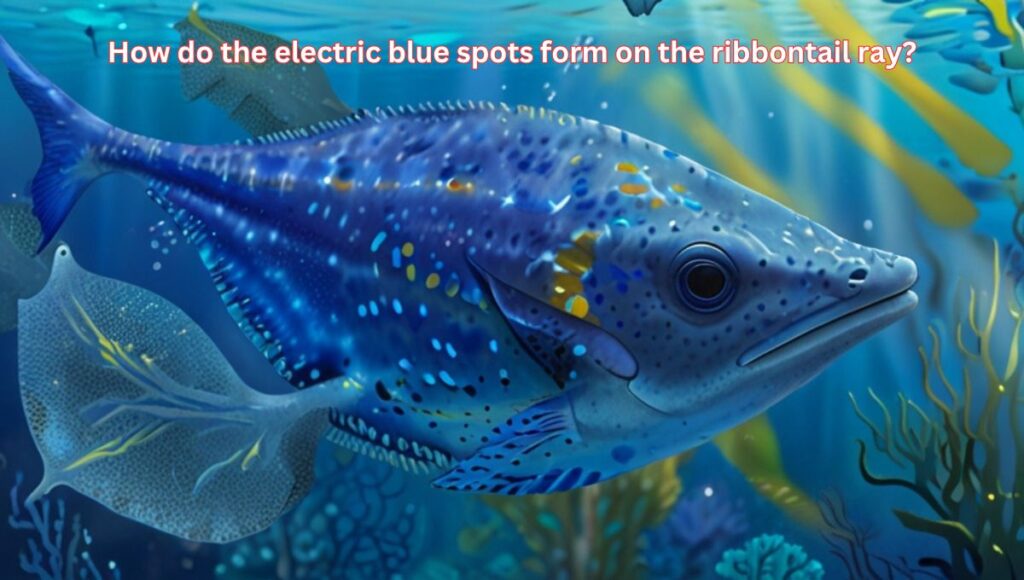A team of international researchers has recently uncovered the unique nanostructures responsible for the electric blue spots on the blue-spotted ribbon tail ray (Taeniura lemma). This discovery could revolutionize chemical-free color production. The team is also examining the blue coloration of the blue shark (Prionace glauca).

The Mysterious Colors of the Ribbontail Ray-
Skin coloration is essential for communication in many organisms, providing visual cues for warning, attraction, or camouflage. The bluespotted ribbontail ray is renowned for its vivid blue spots, but the biological processes behind these spots were a mystery until now.
“Understanding animal structural color involves optical physics, the materials involved, their fine organization in the tissue, and how the color appears in the animal’s environment,” said Mason Dean, senior author and associate professor of comparative anatomy at the City University of Hong Kong (CityU).
“To solve the stingray color puzzle, we assembled a multidisciplinary team from multiple countries.”
The Rarity of Blue Coloration in Nature-
Dean explained that blue coloration in nature is almost always produced by tissue nanostructures rather than pigments. These structural colors are created by nanoscale structures that manipulate light.

“Blue pigments are extremely rare, and nature often uses nanoscale structures to create blue,” said Viktoriia Kamska, a postdoc at CityU studying natural coloration mechanisms.
Analyzing the Fine-Scale Architecture of the Skin-
The researchers employed various techniques to analyze the skin architecture under natural conditions. “We used microcomputed tomography (micro-CT), scanning electron microscopy (SEM), and transmission electron microscopy (TEM) to understand the fine-scale architecture of the skin,” Dean said.
The analyses revealed that the blue color is produced by unique skin cells with a stable 3D arrangement of nanoscale spheres containing reflecting nanocrystals.
“Because the size and spacing of the nanostructures are multiples of the wavelength of blue light, they reflect blue wavelengths specifically,” explained Amar Surapaneni, a postdoc in Dean’s group.
The Bright Blue Skin of the Ribbontail Ray-
The “quasi-ordered” arrangement of these spheres ensures that the color remains unchanged when viewed from different angles.
“A thick layer of melanin underneath the color-producing cells absorbs all other colors, resulting in extremely bright blue skin. The structural color cells focus on the blue color, while the melanin pigment cells suppress other wavelengths,” Dean said.
This bright blue coloration likely provides camouflage benefits. “In water, blue penetrates deeper than any other color, helping animals blend with their surroundings.
The bright blue skin spots of stingrays do not change with the viewing angle, which may offer specific camouflage advantages as the animal swims or maneuvers with its undulating wings,” Dean added.
Future Research Directions-
The researchers are exploring applications for bio-inspired, pigment-less colored materials.
“We are collaborating with fellow researchers to develop flexible biomimetic structurally-colored systems inspired by the soft nature of stingray skin for safe, chemical-free colors in textiles, flexible displays, screens, and sensors,” Dean reported.
The team is also investigating blue coloration in other rays and sharks, including the blue shark. “Despite its name, the blue shark’s coloration mechanism remains unknown,” Kamska said.
“Preliminary results show that the blue shark’s coloration mechanism is different from the stingray’s. We need to use various imaging tools and integrate optics, material, and biological science to uncover this mechanism,” she concluded.
This groundbreaking research not only unveils the mystery behind the blue-spotted ribbontail ray’s electric blue spots but also paves the way for innovative, environmentally friendly color production methods.


